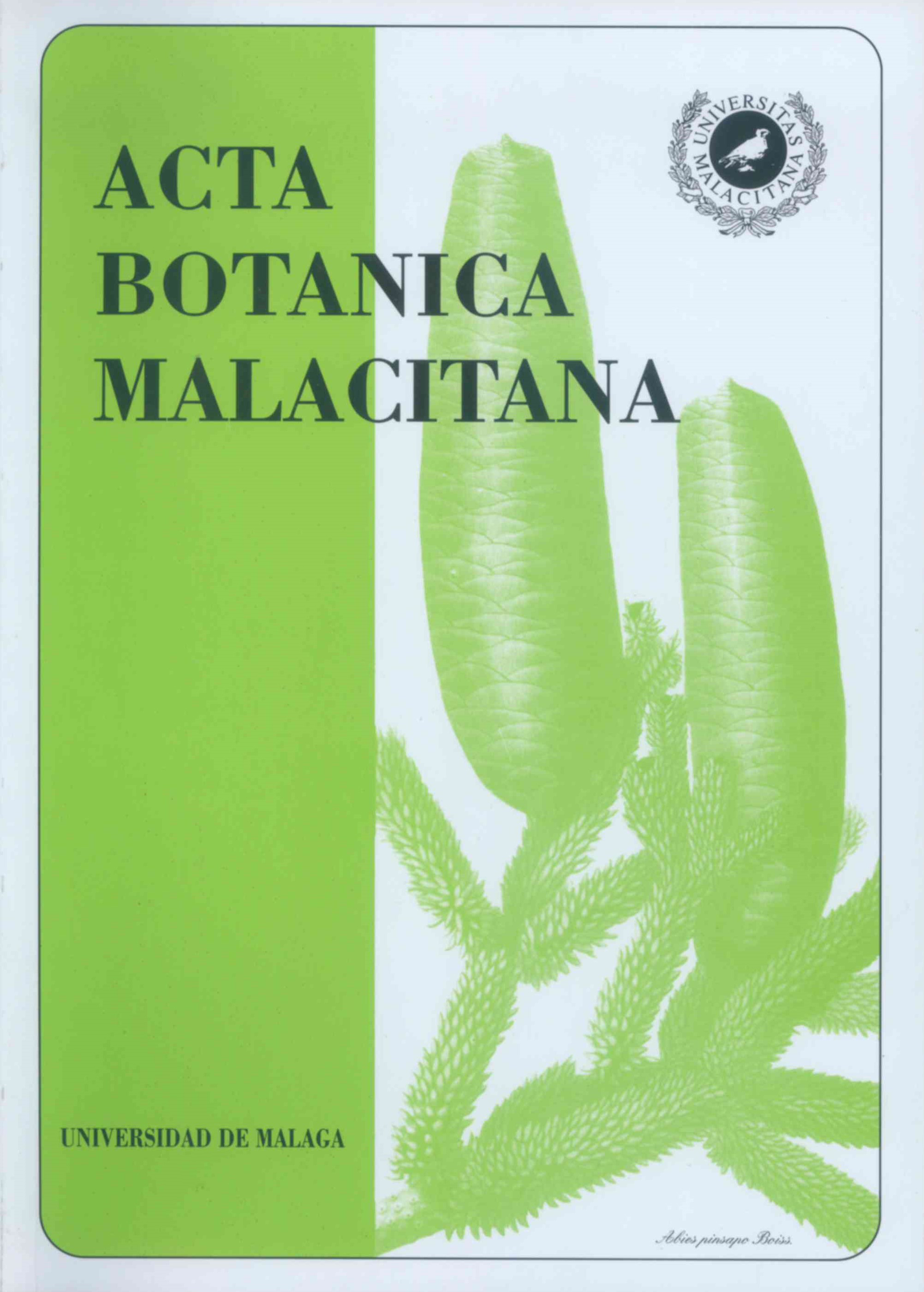New records for three Asplenium hybrids (Aspleniaceae, Pteridophyta) in the Iberian Peninsula
DOI:
https://doi.org/10.24310/abm.v22i0.8602Keywords:
Pteridophyta, Aspleniaceae, Asplenium, hybrids, cytology, morphology, geographical distribution, lberian PeninsulaAbstract
New records for three Asplenium hybrids (Aspleniaceae, Pteridophyta) in the Iberian Península. New Iberian localities are reported for the following Aspleniumhybrids: Asplenium x protomajoricum nothosubsp. protomajoricum (= A. fontanum subsp. fontanumx A. petrarchae subsp. bivalens), A. x recoderi nothosubsp. recoden i (= A. fontanum subsp. fontanum x A. rata-mararia subsp. ruta-muraria) and A. x sleepiae nothosubsp. sleepiae (= A.obovatum subsp. lanceolatum x A. foreziense). Results of the cytological analysis and a description of the main morphological features of the fronds are given.
Downloads
Metrics
References
AIZPURU, I. y P. CATALÁN -1986- Asplenium x recoden, nothosp. nov. Anales Jard. Bot. Madrid 42(2): 531-532.
BADRÉ, F., M. BOUDRIE, R. PRELLI & J. SCHNELLER -1981- Asplenium x sleepiae (A. billotii x A. foreziense) et Asplenium x bouharmontii (A. obovatum x A. onopteris), hybr. nov. (Aspleniaceae, Pteridophyta). Bull. Mus. Mist. Nat. Paris, Adansonia 4: 473-481.
BOUDRIE, M. -1996- Observations pteridologiques dans le departement des Pyrenées-Orientales. Le Monde des Plantes 456: 1-8.
BOUZILLÉ, J.B. & M. BOUDR1E -1991- Cinquieme journee: Samedi 14 avril: les vallees des Alberes. Bull. Soc. Bot. Centre-Ouest, n.s. 22: 365-372.
PANGUA, E., C. PRADA, A. CASTILLO y A.E. SALVO -1990- Asplenium obovatum Viv. en la Península Ibérica. In: J. Rita (Ed.), Taxonomía, Biogeografía y Conservación de Pteridófitos 191-208.
PANGUA, E., C. PRADA, S. PAJARON & A.E. SALVO -1992- A new Asplenium hybrid from Valencia (Spain) related to A. majoricum Litard. Bot. J. Linn. Soc. 108: 1-13.
PÉREZ CARRO, F.J. y M.P. FERNÁNDEZ ARECES -1992- Asplenium x protomajoricum hybrid. nov. (A. fontanum subsp. fontan urn x A. petrarchae subsp. bivalens) y precisiones corológicas sobre A. majoricum en el Levante español. Anales Jard. Bot. Madrid 49(2): 187- 194.
PÉREZ CARRO, F.J. y M.P. FERNÁNDEZ ARECES -1996- Híbridos del género Asplenium L. (Aspleniaceae) en la Península Ibérica. Anales Jard, Bot. Madrid 54(1): 106-125.
RASBACH, H., K. RASBACH, T. REICHSTEIN & H.W. BENNERT -1991- Asplenium trichomanes subsp. coriaceifolium, a new subspecies and two new intraspecific hybrids of the A. trichomanes complex (Aspleniaceae, Pteridophyta). II. Description and illustrations. With an appendix on pairing behaviour of chromosomes in fern hybrids. Wildenowia 21: 239-261.
REICHSTEIN, T. -1981- Hybrids in European Aspleniaceae (Pteridophyta). Bol. Helvetica 91: 89-139.
RIGUAL, A. -1972- Flora y vegetación de la provincia de Alicante. Alicante.
SÁEZ, L., P. CUBAS y J.A. ROSSELLÓ -1993- Asplenium x sleepiae and A. obovatum subsp. obovatum (Aspleniaceae, Pteridophyta) from Cap de Crcus, NE Spain. Nova Hedwigia 57(3- 4): 437-443.
SLEEP, A. -1983- On the genus Asplenium in the Iberian Peninsula. Acta Bot. Malacitana 8: 11- 46.
Downloads
Published
How to Cite
Issue
Section
License
Authors publishing in this journal agree to the following terms:
- Retention of rights
Authors will retain their copyright and grant the journal a non-exclusive distribution right for the first publication of their work. - Usage license
Articles are published under the Creative Commons Attribution 4.0 (CC BY 4.0). This license allows anyone to share and adapt the work as long as authorship is acknowledged and a link to the license is included. - Authors' reuse rights
Authors may reuse, distribute, and archive the published version of their article without restrictions. Depositing the article in institutional repositories, academic social networks, personal blogs, and other platforms is encouraged, as it enhances its visibility and citation within the academic community. - Promotion of dissemination
Authors are allowed and encouraged to share their work on online platforms before and during the submission process. This practice can foster academic exchange and increase the dissemination and impact of the published work.








1.png)
